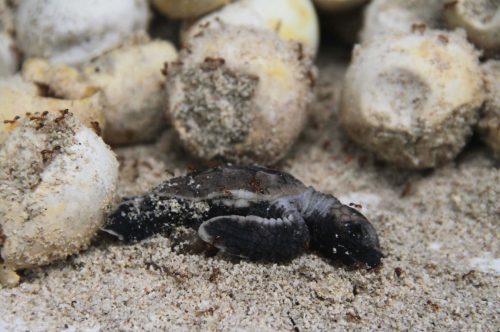Getting to Know the Hawksbill Turtle in Indonesia: Population, Threats, and Conservation Efforts

Photo Credit : Caroline S. Rogers USFWS Southeast
Indonesia, with its vast and diverse waters, is home to six of the seven species of turtles in the world. The turtle species that can be found in Indonesian waters include:
- Olive Ridley Turtle (Lepidochelys olivacea)
- Green Turtle (Chelonia mydas)
- Leatherback Turtle (Dermochelis coriaceae)
- Flatback Turtle (Natator depressus)
- Loggerhead Turtle (Caretta caretta)
- Hawksbill Turtle (Eretmochelys imbricata)
Meanwhile, the turtle species not found in Indonesia is the Kemp’s Ridley Turtle (Lepidochelys Kempi). Its original habitat is on the beaches of Mexico and it is categorized as the most endangered and most protected turtle in the world.
The Role of Turtles in the Marine Ecosystem
Turtles are an important part of the marine ecosystem in Indonesia. Despite facing threats, conservation efforts continue to be made to protect these species. Turtles play a significant role in the marine ecosystem, and here are some examples:
- Controlling Seagrass : Green Turtles play a crucial role in controlling the growth of seagrass that could potentially obstruct sea currents and block sunlight from reaching underwater life.
- Controlling Sponge Population : Hawksbill Turtles play a role in controlling the population of sponges that threaten the survival of coral reefs due to aggressive competition for space. By preying on sponges, hawksbill turtles also feed other marine species from these nutrients.
- Providing Habitat : More than 100 Epibiont species live on the shell of the loggerhead turtle.
Hawksbill Turtle
The Hawksbill Turtle (Eretmochelys imbricata) is one of six turtle species that can be found in Indonesian waters. This species is of particular interest because it is one of the smallest turtle species. Some of its distinctive features include a narrow, pointed beak, and a beautifully patterned shell. The Hawksbill Turtle has a global distribution, with two subspecies found in the Atlantic and Pacific. In Indonesia, hawksbill turtles are commonly found in the Riau Islands to Belitung, Lampung, Thousand Islands, Karimunjawa, Sulawesi Sea (Berau), South Sulawesi (Takabonerate) to Southeast Sulawesi (Wakatobi), Maluku, and Papua.
It is difficult to know the exact population of Hawksbill Turtles, but research indicates that there are only five populations worldwide, consisting of about 8,000 total turtles, and with only 1,000 females nesting each year. Unfortunately, the population of green turtles and hawksbill turtles in Indonesia continues to decline year after year.
The main reason for the decline in the Hawksbill Turtle population is poaching and the trade of turtles and their eggs. If patrolling and combing are carried out intensively and regularly, many cases of buying and selling turtle eggs and other parts of the turtle body will be found, both openly and behind the scenes. Some of the cases above provide a glimpse that these protected species are still threatened. In addition, in one province in Indonesia, turtles have been used for religious activities since the 1970s. Despite regulations prohibiting the trade of turtles, turtles are still used in religious ceremonies.

Photo Credit : Falahi Mubarok/Mongabay Indonesia
Hawksbill Turtle Conservation Efforts in Indonesia
Here are some efforts made by the Indonesian government to protect the Hawksbill Turtle:
- Strengthening Regulations : All types of turtles in Indonesia, including the Hawksbill Turtle, are protected under Government Regulation (PP) No. 7 of 1999 concerning the Preservation of Plant and Animal Species. The Ministry of Marine Affairs and Fisheries (KKP) has also designated six types of turtles for this category.
- National Action Plan (RAN) : The Indonesian government has established a national scale turtle conservation RAN document through the Decree of the Minister of Marine Affairs and Fisheries No. 65 of 2022 for the period 2022-2024.
- Population Monitoring and Turtle Nest Conservation : Population monitoring and turtle nest conservation continue to be carried out in several priority conservation locations to preserve their populations in nature.
- Community Involvement and Awareness : The government is also striving to increase community involvement and awareness in turtle conservation efforts.
- Research and Monitoring : The government also conducts research and monitoring to obtain scientific data on the distribution, population size, bioecological aspects, threats, and socio-economics of turtle survival.
Despite being protected by domestic and international regulations, the existence of turtles in the sea, especially in the open sea, is still threatened. Reasons for Extinction In addition to hunting and trading, another factor contributing to the extinction of turtles in Indonesia is the presence of plastic waste. Turtles often die because they get caught in nets and because they eat plastic waste. Hawksbill Turtle Conservation Efforts in Indonesia Various turtle conservation efforts have been carried out by several parties, including:
- Nagaraja Turtle Conservation Community
- Pangumbahan Sukabumi Turtle Conservation
- Aceh Besar District Turtle Conservation Community
Various turtle conservation efforts, both those carried out structurally through policies, regulations, rules to the threat of punishment and cultural conservation efforts through socialization, have been and will continue to be carried out. The hope is that when Indonesia becomes home to many animals including turtles, at that time Indonesia can become a place of refuge instead of a hunting ground.

